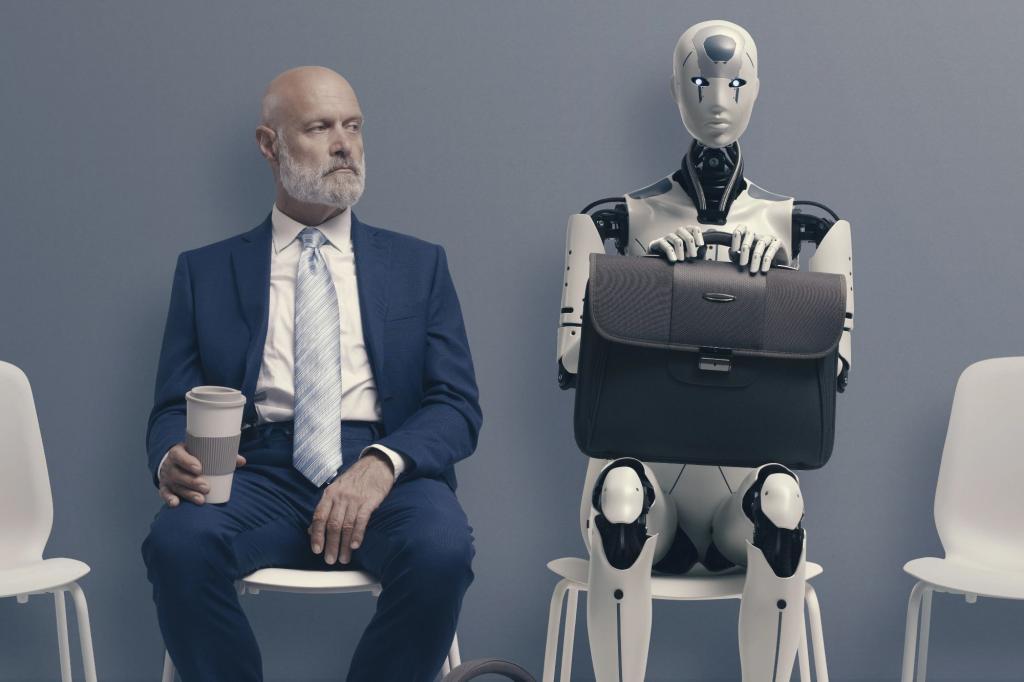AI-Driven Job Displacement: A Looming Crisis for White-Collar Workers
2 Sources
2 Sources
[1]
The A.I. Workforce Displacement Crisis: Why Traditional Retraining Models Are Failing
A new labor crisis is looming as A.I. automates jobs and exposes the deep structural lag in U.S. education. America's education system is dangerously out of sync with the speed and scale of A.I., and if it doesn't catch up soon, it could trigger the largest unemployment crisis since the Great Depression. In just the first half of 2025, A.I. has already contributed -- directly or indirectly -- to the elimination of over 80,000 jobs across nearly 400 major corporations. Microsoft cut 6,000 positions in May. IBM laid off 8,000 employees as part of a broader effort to integrate A.I. into its operations. Salesforce cut 1,000 roles earlier this year and has paused hiring for customer service agents, engineers and lawyers, allowing A.I.-powered tools to fill gaps. Intel is set to slash 15 to 20 percent of its factory workforce, and Meta continues automating roles that once required human oversight. Sign Up For Our Daily Newsletter Sign Up Thank you for signing up! By clicking submit, you agree to our <a href="http://observermedia.com/terms">terms of service</a> and acknowledge we may use your information to send you emails, product samples, and promotions on this website and other properties. You can opt out anytime. See all of our newsletters Estimates suggest that 25 to 50 percent of jobs face significant A.I. exposure, impacting 40 to 80 million Americans in the coming years. Yet our education and retraining systems are wholly unprepared for a shift of this magnitude. The misalignment is structural: traditional education operates on slow cycles that span semesters and years, while A.I. technologies evolve in months or weeks. In some cases, they advance so rapidly that entire job categories may vanish within a four-year degree cycle, with universities falling short of teaching students the skills they'll actually need by graduation. The World Economic Forum projects 92 million roles could be displaced by 2030, but the 170 million new positions set to be created, resulting in a 78 million net increase, might require skills not yet found in any curriculum. Consider the timeline disconnect: A computer science major who begins their degree in 2025 will finish in 2028 with a curriculum rooted in 2023, but by then, A.I. models and methodologies will have iterated dozens of times and rendered entire programming languages obsolete. Universities face institutional barriers that make rapid adaptation nearly impossible, forcing them to play catch-up rather than lead innovation in A.I. education. Curriculum changes require faculty committee approval, accreditation reviews and administrative processes that routinely take 18 months or more. By the time a new A.I. course is approved, the technology it was designed to teach may already be superseded. Faculty hiring cycles, research publication timelines and tenure track requirements create incentives that reward theoretical knowledge over cutting-edge practical application, and the result is an education system that treats A.I. as an academic subject rather than a fundamental shift in how work gets done. Meanwhile, millions of workers lack the resources needed to adapt. According to the Center for Economic Policy Research, nearly half of American workers face some degree of automation-related displacement over the next decade. Yet, many lack basic access to the basic infrastructure increasingly necessary for upskilling, like high-speed internet, ChatGPT subscriptions or modern devices capable of running A.I. applications. A.I. training courses often cost over $1,000, far out of reach for the very cashiers, warehouse staff and entry-level office workers who are most likely to face displacement. Unlike K-12 lunches or school funding, there is no widespread public investment ensuring that A.I. education is universally available. And many states already struggling to fund basic tech in classrooms are unlikely to allocate resources toward retraining displaced workers at scale. If conservative estimates prove accurate, between 40 and 80 million people in the workforce will need simultaneous retraining. We're essentially asking a system already struggling with overcrowding to serve tens of millions more -- an impossible 400 percent capacity increase. Meeting that challenge without coordinated federal action and significant new investment will prove a logistical fantasy. Tens of millions of Americans could effectively be priced out of the future, unable to reskill or re-enter the workforce through traditional solutions that will inevitably strain under the scale and speed of A.I.-driven change. Existing workforce systems aren't designed for this. Unemployment systems operate on assumptions of three to five percent rates during recessions, not 25 to 50 percent displacement. Corporate retraining programs serve existing employees but ignore the broader social impact of mass layoffs, and platform-based services like LinkedIn Learning work well for the motivated few, but cannot coordinate society-wide reskilling efforts. The solution must match A.I.'s characteristics: scalable, adaptive and fast. We need a nationwide A.I. education initiative that positions A.I. training tools as public utilities -- akin to the interstate highway system or rural electrification -- while fast-tracking approvals for new programs and building public-private partnerships for broad access. Platforms like CYPHER Learning, Cornerstone and Flashpass, which have partnerships with AI Owl, Intel and Khan Academy, can personalize learning pathways, identify skill gaps and adapt to new market demands in real time. These platforms have two key advantages: per-learner costs stay low, making universal access economically feasible at a scale and speed that traditional education cannot match, and curricula updates happen in weeks, not years. The timeline for action is shorter than political cycles typically allow, but A.I. capabilities will continue to advance at breakneck speed regardless of legislative schedules or budgetary debates. We must build the infrastructure to retrain millions now, before the unemployment crisis becomes irreversible: the workers facing displacement this year cannot wait for comprehensive policy solutions that take effect in 2027 or 2028. Politics and traditional education both move in four-year cycles. A.I. moves in months. How fast will America move to meet the challenge?
[2]
White collar workers displaced by AI could spark a revolution
Earlier this month, Microsoft announced plans to lay off 9,000 employees, joining the ranks of tech companies cutting headcounts while touting the productivity gains enabled by artificial intelligence. According to CEO Satya Nadella, up to 30% of the company's code is now being written by AI. Salesforce CEO Marc Benioff one-upped him after his own firm's layoffs, claiming that up to 50% of their work is now being shouldered by AI. These are not simply corporate earnings call updates. They are previewing the future of work in America. Claims from leaders at OpenAI and Anthropic that their products will change the world deserve some skepticism. After all, snake oil salesmen project confidence, too. But when layoffs start happening and the heads of publicly traded companies tell you why, it's worth listening. The question isn't whether AI will displace workers, but which workers -- and what happens when America's comfortable laptop class finds itself on the wrong side of technological disruption for the first time. Over the past 50 years, Americans were sold on the promise of globalization and the idea that we'd lead the world in knowledge work and no longer have to make things ourselves. We'd "learn to code" and someone halfway around the world would assemble our iPhones. College-for-all became the guiding principle of education policy, and the dollars followed: Since 1980, public spending on higher ed has more than doubled. Meanwhile, career and technical education -- the kinds of programs that lead to good blue-collar jobs after high school -- has been ignored, with its share of federal K-12 spending dropping to low single digits. In other words, America has systematically overinvested in precisely the kinds of jobs AI seems primed to disrupt. Right now, these disruptions seem largely focused in the tech sector. But that's likely a harbinger of things to come. The history of innovation shows repeatedly that when general-purpose technologies are introduced, they take time to diffuse throughout the economy -- and the first place we see disruption is in their own industry. Electricity is a perfect example. As the economic historian Paul David shows, the first productivity bump from electrification was confined to the power plants themselves -- they learned to squeeze more kilowatt-hours from each ton of coal and worker. Only gradually, over the following decades, did factories reorganize around electric motors, and only then were these gains mirrored across the economy. In computing, too, David shows how the initial gains were seen in the computer manufacturing sector, followed by sectors that were already using early computers the most. Eventually, every company from Walmart to Bank of America had its own IT department. AI seems to be in the early stages of following this precise pattern, starting on its home turf of software. It's one thing for software engineers to be concerned for their futures, quite another for mass layoffs to hit economy-wide. Just as electrification ultimately came for agriculture and manufacturing, AI will come for law, and banking, and marketing. When the last big economic disruption of globalization struck blue-collar workers, sending manufacturing jobs overseas, the result was hollowed-out communities, an opioid crisis and an unfulfilled promise of "retraining" for "the jobs of the future." Now, the AI wave is primed to hit those exact jobs, and the people who built their own prosperity on the wave of globalization that left so many others behind. But this isn't just a mirror image of the globalization crisis. On the one hand, high-income, highly educated elites have much greater resources at their disposal to weather an economic storm. On the other, the power elites hold may pose a far greater risk to political and social stability when they find themselves under threat. The complexity scientist Peter Turchin has shown how, throughout history, an excess of elites with poor economic prospects is the path to political instability. Going back as far as the late Roman Republic, elite overproduction is a key contributor to chaos (alongside stagnating or declining general living standards and increased public debt -- which may sound familiar). The American laptop class is a political powder keg. As the comfortable jobs they were promised become harder to land, and the self-validating stories they told themselves of their own value come unwound, competition will become fierce. As more and more of them end up on the losing side, Occupy Wall Street may look like a mild preview of what's to come. How long will this all take? If we have decades to adapt, older workers will have time to learn new skills while younger workers can adjust their own career paths. New industries can spring forward to use the labor no longer dedicated to litigating in court, speculating in markets and posting on social media. But if the disruption happens more quickly, we risk creating millions of displaced knowledge workers who will have not only the skills and networks, but also the time and motivation to organize a radical political movement. Predictions about what's to come are mostly educated guesses, drawing on history and an expectation that the lines on the graph will continue to go up. This is not enough. Policymakers cannot neither rest comfortably in Sam Altman's promises of utopia, nor overreact to overwrought warnings with regulation that short-circuits valuable innovation that may take decades to deploy, nor simply wait and see what happens. The Bureau of Labor Statistics should begin to track AI displacement in real-time, sector by sector, occupation by occupation. Instead of waiting for quarterly employment reports that tell us what happened months ago, live data should highlight which jobs are disappearing and where new ones are emerging. Anthropic has already begun leading the way on this type of research, reporting how its tools are being used within each of the BLS's job categories. AI has the potential to remake the American economy -- it may already have started. The last century was defined by the remarkable gains of technological progress as electrification and then the digital revolution washed across society, and the shocking costs of foolish enthusiasm for the rapid disruptions of globalization and deindustrialization. The next will be defined in part by which of these transitions AI resembles. The choice isn't whether AI will displace knowledge workers -- it's whether we'll see the disruption coming and prepare accordingly, or wait for the laptop class to take to the streets.
Share
Share
Copy Link
AI is rapidly automating jobs across various sectors, particularly affecting white-collar workers. This trend is exposing significant gaps in the US education and retraining systems, potentially leading to a major unemployment crisis.
The Rise of AI-Driven Job Displacement
The rapid advancement of artificial intelligence (AI) is reshaping the job market at an unprecedented pace, with white-collar workers now finding themselves on the front lines of technological disruption. In the first half of 2025 alone, AI has contributed to the elimination of over 80,000 jobs across nearly 400 major corporations
1
. Tech giants like Microsoft, IBM, and Salesforce have already implemented significant layoffs, with AI tools filling the gaps left by human workers1
.Scale of the Crisis

Source: New York Post
Estimates suggest that 25 to 50 percent of jobs face significant AI exposure, potentially impacting 40 to 80 million Americans in the coming years
1
. The World Economic Forum projects that by 2030, 92 million roles could be displaced, although 170 million new positions may be created1
. However, these new jobs might require skills not yet found in any curriculum, highlighting the urgent need for educational reform.Education System's Structural Lag
The American education system is dangerously out of sync with the speed and scale of AI advancements. Traditional education operates on slow cycles that span semesters and years, while AI technologies evolve in months or weeks
1
. This misalignment is creating a critical skills gap, with universities struggling to teach students the skills they'll actually need by graduation.Barriers to Rapid Adaptation

Source: Observer
Universities face significant institutional barriers that hinder rapid adaptation to AI advancements. Curriculum changes often require lengthy approval processes, and faculty hiring cycles and tenure track requirements create incentives that prioritize theoretical knowledge over cutting-edge practical application
1
. This results in an education system that treats AI as an academic subject rather than a fundamental shift in how work gets done.Retraining Challenges and Inequality
The current retraining infrastructure is ill-equipped to handle the scale of displacement caused by AI. Many workers lack access to basic resources needed for upskilling, such as high-speed internet or modern devices capable of running AI applications
1
. AI training courses are often prohibitively expensive for those most likely to face displacement, creating a potential scenario where tens of millions of Americans could be priced out of the future workforce.Related Stories
Political and Social Implications
The displacement of white-collar workers by AI could have far-reaching political and social consequences. Unlike previous waves of technological disruption that primarily affected blue-collar workers, this shift targets the "laptop class" – a group with significant political and social influence
2
. Historical patterns suggest that an excess of elites with poor economic prospects can lead to political instability, potentially making movements like Occupy Wall Street seem mild in comparison2
.Need for Proactive Measures
To address this looming crisis, experts suggest the need for a nationwide AI education initiative that positions AI training tools as public utilities
1
. Fast-tracking approvals for new programs and building public-private partnerships for broad access could help create a more adaptive and scalable education system. Additionally, policymakers are urged to track AI displacement in real-time across various sectors and occupations to better understand and respond to the changing landscape2
.Conclusion
The AI-driven job displacement crisis presents a complex challenge that requires immediate attention from policymakers, educators, and industry leaders. Failure to address this issue could result in widespread unemployment, increased inequality, and potential social unrest. As AI continues to reshape the job market, the need for innovative solutions and proactive measures becomes increasingly urgent.
References
Summarized by
Navi
[2]
Related Stories
Recent Highlights
1
Google launches Gemini 3 Flash as default AI model, delivering speed with Pro-grade reasoning
Technology

2
OpenAI launches GPT Image 1.5 as AI image generator war with Google intensifies
Technology

3
OpenAI launches ChatGPT app store, opening doors for third-party developers to build AI-powered apps
Technology








